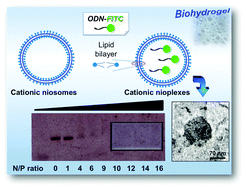Cationic nioplexes-in-polysaccharide-based hydrogels as versatile biodegradable hybrid materials to deliver nucleic acids†
Abstract
Two polysaccharide-based hydrogels made of only κ-carrageenan (4%; w/v) or of a mixture of methylcellulose:κ-carrageenan (2%; w/v) were used to encapsulate cationic nioplexes. These vesicular particles were made of a synthetic aminolipid and polysorbate-80 (Tween-80), as a non-ionic surfactant agent. According to oscillatory rheological measurements, the presence of nioplexes did not compromise the mechanical integrity of the gels. In vitro niosomal release experiments demonstrated the liberation of nioplexes up to 24 h, and the curves were fitted according to Higuchi, Korsmeyer–Peppas and Weibull equation models, which indicated Fickian-diffusion controlled mechanisms. Besides nioplexes, cervical cancer cells were also entrapped within the biohydrogels. Cell release confirmed that these materials did not affect the cell viability, allowing cells to spread and proliferate after 24 h. The applicability of these biocompatible hydrogels was also extended to gene delivery. In this regard, the best silencing activities were found when cationic niosomes were complexed with antisense oligonucleotides in KC hydrogels. Nioplexes were able to release through the hydrogel and promoted silencing of luciferase expression in the presence of serum without using commercially available cationic lipids. Overall, the formation of such hybrid materials by integrating cationic nioplexes within biodegradable hydrogels provides a new perspective for the delivery of macromolecular therapeutics.



 Please wait while we load your content...
Please wait while we load your content...